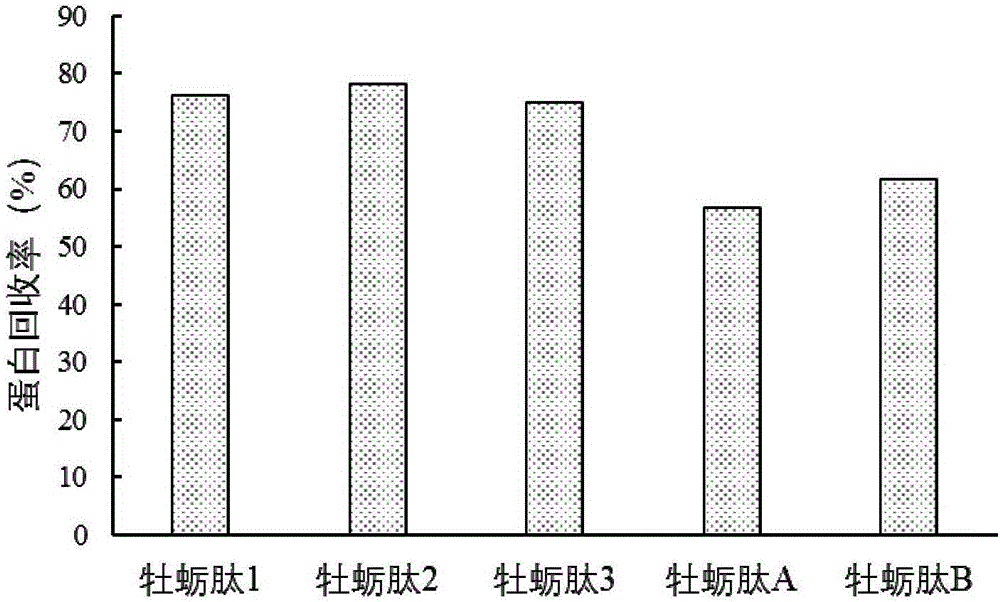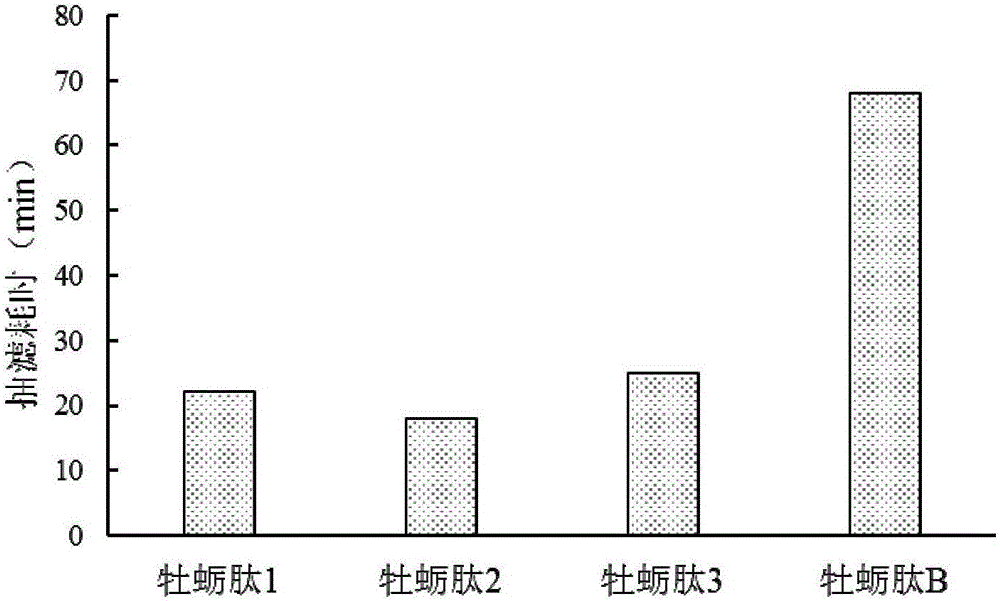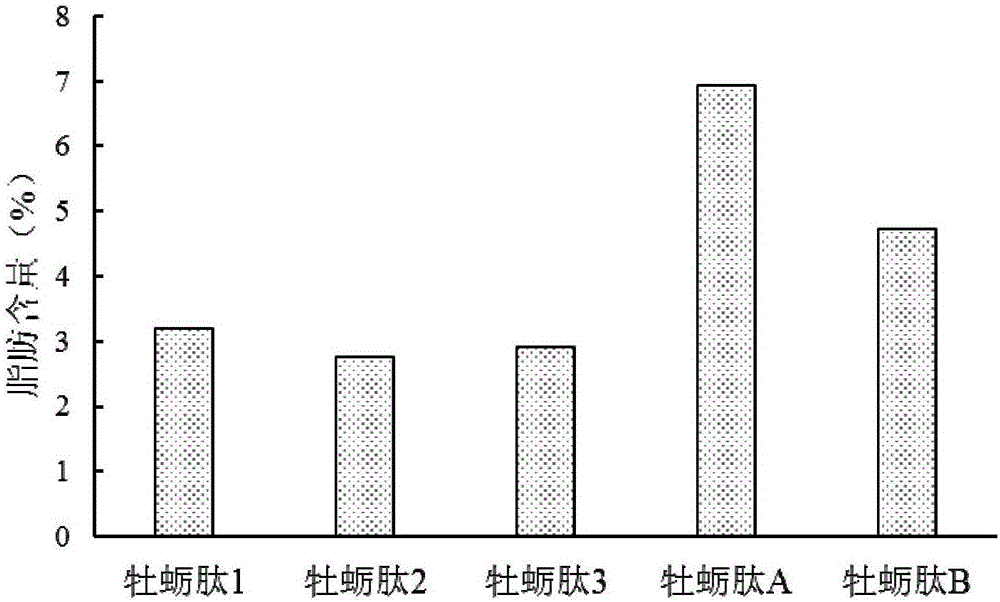Method for quickly separating oyster peptide from oyster enzymolysis liquid
An enzymatic hydrolysate and oyster peptide technology, which is applied in the field of rapid separation of oyster peptides, can solve the problems of unclear interface between the water phase and oil phase of the oyster protease hydrolyzate, difficulty in separation and extraction of oyster peptides, and influence on the separation of enzymatic hydrolyzed products. The effect of oil-water separation, low production cost and easy operation
- Summary
- Abstract
- Description
- Claims
- Application Information
AI Technical Summary
Problems solved by technology
Method used
Image
Examples
Embodiment 1
[0049] A method for rapidly separating oyster peptides from oyster hydrolyzate, comprising the following steps:
[0050](1) Fresh oyster meat is cleaned, mixed with water according to a mass ratio of 1:1, and passed through a colloid mill to obtain oyster slurry; then adjust the pH value of the system to 7.0, add papain with 0.2% oyster meat mass, and hydrolyze 6 oysters at 55 ° C. hours, and then heated at 90°C for 15 minutes to inactivate the enzyme to obtain oyster hydrolyzate;
[0051] (2) Add 0.15% sucrose ester and 0.15% monoglyceride to the oyster enzymatic hydrolyzate mass (dry matter) of the oyster enzymatic hydrolyzate after deactivating the enzyme, adjust the pH value of the oyster enzymatic hydrolyzate to 8.0, add oyster enzyme Lipase with a solution mass (dry matter) of 1.0%, fully mixed, incubated and hydrolyzed at 35°C for 8 hours, and then heated at 95°C for 15 minutes to inactivate the enzyme to obtain the secondary enzymatic hydrolysis product of oysters;
...
Embodiment 2
[0054] A method for rapidly separating oyster peptides from oyster hydrolyzate, comprising the following steps:
[0055] (1) Clean the fresh oyster meat, add water and mix according to the mass ratio of 1:1, pass through the colloid mill to obtain the oyster slurry; then adjust the pH value of the system to 6.0, add 0.2% of the oyster meat mass to trypsin, and hydrolyze at 50°C for 5 hours, and then heated at 90°C for 15 minutes to inactivate the enzyme to obtain oyster hydrolyzate;
[0056] (2) Demulsification of the oyster enzymatic hydrolysis system: add 0.08% sucrose ester and 0.12% monoglyceride to the oyster enzymatic hydrolyzate after deactivating the enzyme to adjust the oyster enzymatic hydrolyzate When the pH value reaches 7.0, add 1.5% lipase in oyster enzymatic hydrolyzate mass (dry matter basis), mix thoroughly, heat-preserve and hydrolyze at 40°C for 6h, then heat at 95°C for 15min to inactivate the enzyme, and obtain the second enzymatic hydrolysis of oyster pr...
Embodiment 3
[0059] A method for rapidly separating oyster peptides from oyster hydrolyzate, comprising the following steps:
[0060] (1) Clean the fresh oyster meat, add water and mix according to the mass ratio of 1:1, and pass through the colloid mill to obtain the oyster slurry; then adjust the pH value of the system to 6.5, add 0.4% alkaline protease of the oyster meat mass, and hydrolyze at 60°C 5 hours, and then heated at 90°C for 15 minutes to inactivate the enzyme to obtain the oyster hydrolyzate;
[0061] (2) Add 0.05% sucrose ester and 0.05% monoglyceride to the oyster enzymatic hydrolyzate mass (dry matter) of the oyster enzymatic hydrolyzate after deactivating the enzyme, adjust the pH value of the oyster enzymatic hydrolyzate to 7.5, add oyster enzyme Lipase with a solution mass (dry matter) of 2.0%, fully mixed, incubated and hydrolyzed at 35°C for 4 hours, and then heated at 95°C for 15 minutes to inactivate the enzyme to obtain a secondary enzymatic hydrolysis product of o...
PUM
 Login to View More
Login to View More Abstract
Description
Claims
Application Information
 Login to View More
Login to View More - Generate Ideas
- Intellectual Property
- Life Sciences
- Materials
- Tech Scout
- Unparalleled Data Quality
- Higher Quality Content
- 60% Fewer Hallucinations
Browse by: Latest US Patents, China's latest patents, Technical Efficacy Thesaurus, Application Domain, Technology Topic, Popular Technical Reports.
© 2025 PatSnap. All rights reserved.Legal|Privacy policy|Modern Slavery Act Transparency Statement|Sitemap|About US| Contact US: help@patsnap.com



